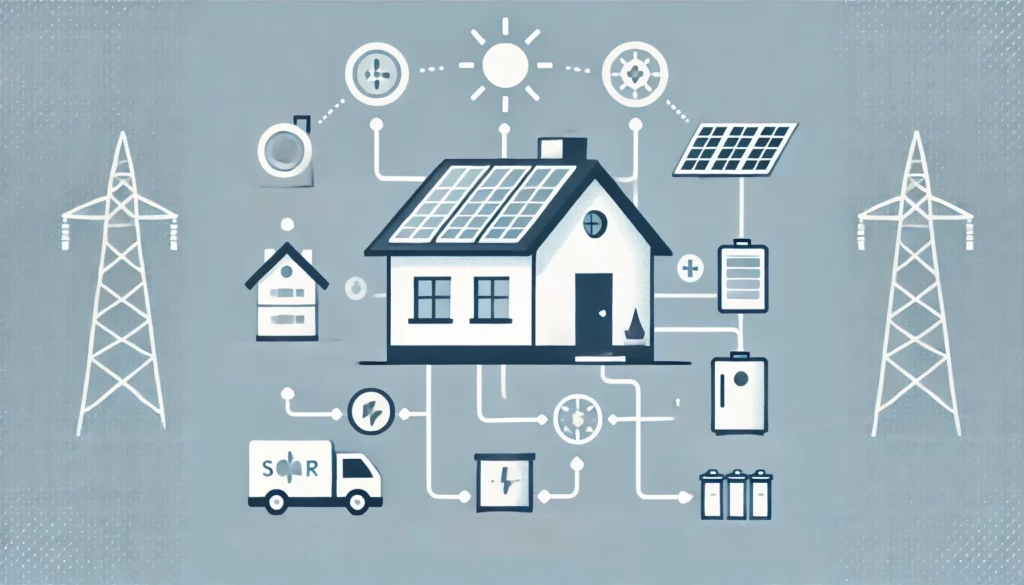Image source: Canva.com
Determining the right number of solar batteries for your energy storage system is crucial for ensuring that your solar power setup meets your needs effectively. Whether you’re looking to enhance your energy independence, provide backup power during outages, or maximize the use of solar energy, calculating the appropriate number of batteries is a key step in optimizing your system’s performance.
This article will guide you through the process of calculating how many solar batteries you need by exploring factors such as your household’s energy consumption, battery capacity, and desired level of energy autonomy. We’ll cover essential concepts like battery depth of discharge, system sizing, and how to match battery storage to your solar panel output. By understanding these elements, you’ll be equipped to design a solar energy storage system that provides reliable power and aligns with your specific energy goals.
Reasons for Installing a Solar Battery
Choosing to install a solar battery system is a significant decision that can be driven by various motivations, each impacting the number of batteries you will need. Generally, people invest in solar batteries for three primary reasons: to maximize savings, ensure resilience during power outages, or achieve full self-sufficiency.
Maximizing Savings
If your goal is to maximize savings on your electricity bills, you’ll need to tailor your battery storage to cover peak electricity pricing hours. Peak pricing can vary based on location and utility plans, but generally, you’ll need enough energy storage to avoid drawing power from the grid when electricity rates are highest. Typically, having two to three solar batteries can provide sufficient storage to cover these peak periods and minimize reliance on grid power, especially when solar panels are not producing energy. This approach helps you fully capitalize on your solar investment by reducing your overall electricity costs.
Backup Power
For those focused on resilience and maintaining power during emergencies, solar batteries offer a reliable solution. A single battery might be sufficient if your primary concern is keeping essential appliances running during brief outages or severe weather conditions. This setup ensures that critical functions such as refrigeration, lighting, and communication devices remain operational when the grid is down.
Going Off-Grid
Achieving complete off-grid capability requires a more substantial investment in battery storage. To be entirely self-sufficient, you’ll typically need between eight to twelve or more batteries, depending on your energy consumption and location. Off-grid living demands a significant amount of storage to cover extended periods without sunlight, such as during prolonged cloudy weather or at night. Adequate battery capacity is essential to ensure that your energy needs are met consistently without relying on the grid.
In summary, the number of solar batteries you need depends largely on your specific goals – whether that’s maximizing financial savings, ensuring backup power during outages, or achieving full off-grid independence. Understanding your needs and energy consumption patterns will guide you in determining the optimal battery storage to meet your objectives effectively.
Factors Influencing Storage System Sizing

Electricity Loads
Your home’s electrical load comprises all devices consuming electricity, such as refrigerators, air conditioners, dishwashers, and other appliances. Accurately sizing a storage system requires understanding how much electricity these appliances use.
Methods to estimate electricity load:
Department of Energy’s (DOE) Appliance Energy Calculator
Estimates annual energy consumption and costs based on average appliance power requirements.
Energy Monitoring Systems
Provide real-time insights into your energy usage, often down to the individual appliance level, helping you understand patterns and peak usage times.
Historical Electricity Bills
Review past bills to identify usage patterns and peak consumption times, offering insights into your electrical load over time.
Solar Panel System Size
The power output of your solar panels determines how much they can charge your battery system daily. Matching the size of your solar panel system with your battery storage ensures efficient energy utilization.
Ways to monitor solar panel production:
Solar Monitoring Systems
Offer detailed production data and insights, often accessible via user-friendly apps provided by top manufacturers.
Electricity Meters
Common in grid-tied systems, these meters track electricity production, helping optimize battery system design based on actual solar output.
Utility Electricity Rate
Your utility rate structure—whether flat or variable—affects how you optimize your battery storage usage.
Considerations based on rate structures:
Flat-Rate Structure
Aim to minimize grid reliance by storing excess solar energy for later use, maximizing long-term savings.
Variable Rate Plans (e.g., Time-of-Use, Demand Charges)
Size your storage system to offset high-cost periods, ensuring you can avoid expensive peak rates.
Demand Response Programs
Participate in utility programs that compensate battery owners for supplying electricity during peak demand periods, influencing storage capacity considerations.
Each of these factors plays a crucial role in determining the optimal size and configuration of your solar battery storage system based on your specific energy needs and goals.
Calculating the Number of Solar Batteries Needed
Before determining how many solar batteries you need to power your home, gather the following information:
Time (hours)
Determine how many hours per day you intend to use stored energy.
Electricity Demand (kW)
Calculate the combined power consumption of all appliances and systems you plan to operate during those hours.
Battery Capacity (kWh)
Note that the typical solar battery has an average capacity of around 10 kilowatt-hours (kWh).
Once you have these figures, follow these steps:
1. Calculate Electricity Demand
Multiply the power demand (in kW) of the appliances by the number of hours they will be in use. This gives you the total kilowatt-hour (kWh) capacity required for storage.
For example, if you have a 1,500 W dishwasher running for 1 hour, a 3,000 W air conditioner for 2 hours, an 800 W refrigerator running constantly, plus additional appliances totaling 1,000 W, you might calculate:
- Dishwasher: 1.5 kW x 1 hour = 1.5 kWh
- Air conditioner: 3 kW x 2 hours = 6 kWh
- Refrigerator: 0.8 kW x 24 hours = 19.2 kWh (assuming continuous use)
- Miscellaneous appliances: 1 kW x 24 hours = 24 kWh
Total electricity demand: 1.5 kWh + 6 kWh + 19.2 kWh + 24 kWh = 50.7 kWh per day
2. Calculate Number of Batteries Needed
Determine how many batteries are required based on their usable capacity. If each battery has a usable capacity of 10 kWh:
For saving money
If you aim to avoid grid electricity during peak hours from 5:00 PM to 9:00 PM, you’ll need 20.7 kWh of stored electricity, or approximately two solar batteries.
For backup power
To cover the electricity demand during a typical power outage, such as the 6.3 kW load from the dishwasher, one battery would suffice for over an hour.
For going off-grid
To sustainably power your home without relying on the grid, you’ll need enough stored electricity to cover periods of low solar production. With solar panels generating electricity for 5 hours a day, you would require about 120 kWh of battery capacity to meet a 6.3 kW load continuously, equivalent to approximately 12 average solar batteries.
By accurately estimating your electricity usage and understanding your storage needs, you can effectively size your solar battery system to meet your specific goals, whether it’s maximizing savings, ensuring backup power, or achieving complete energy independence.
You can choose from a variety of batteries on our Batteries page.





